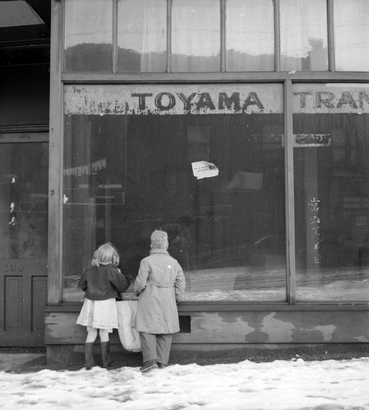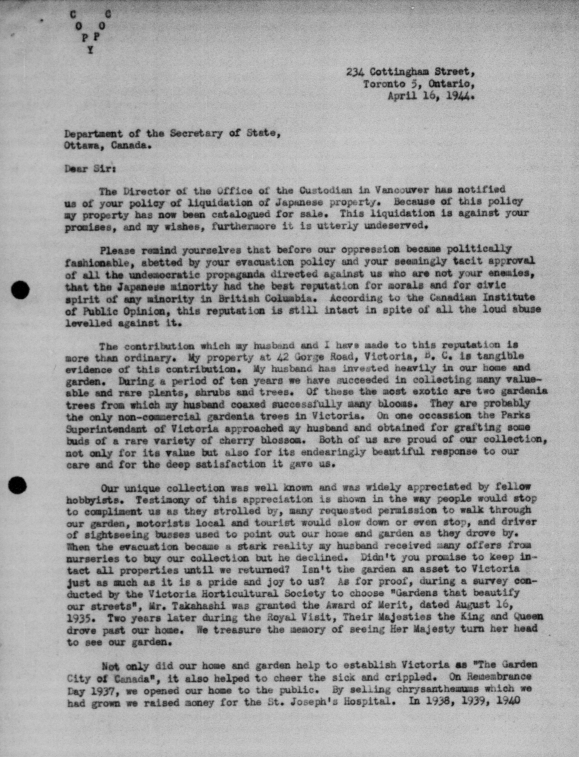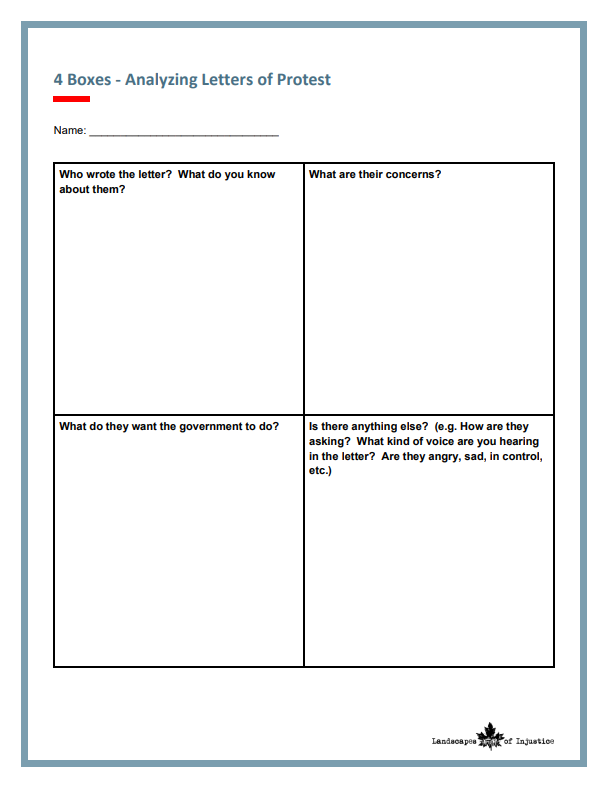Lesson: Letters of Protest
Students read letters of protest from dispossessed Japanese Canadians to see how some of them reacted to the losses they suffered.
 Scroll down
Scroll down
Why
Know
- Immigration to BC (Canada) and resulting growth of cities
- Contributions of immigrants to Canada’s development
Do
- Ask questions, corroborate inferences, and draw conclusions (Evidence)
Core Skills
- Understand interconnected aspects of cultural identity (Positive Personal and Cultural Identity)
First People’s Principles of Learning
- Learning is embedded in memory, history, and story
- Learning is holistic, reflexive, reflective, experiential, and relational (focused on connectedness, relationships and a sense of place)
How
-
If you have not done so yet, now is the time to tell students that in 1943, the government sold Japanese Canadians’ land, businesses, and property back at home without their permission while the Japanese Canadians were incarcerated in camps or forced to live and work on the farms of the Prairies. (If you chose to do the Powell Street simulation, this issue would have come up as the avatars’ possessions were removed after being forced out of Powell Street.) You can tell them (from our introduction):
What happened to their homes and possessions? When they were forced from their homes, Japanese Canadians were told that they could take with them only what they could carry (two suitcases or 150 lbs for adults and 75 lbs for children). Their homes, businesses, farms, furniture, and other possessions were to be held for safe keeping by the “Custodian of Enemy Alien Property” who later sold everything without the owners’ consent and at a small percentage of their prewar value. When restrictions were lifted in 1949, four years after the war, Japanese Canadians had to start all over again. They had no homes to return to.
- Analyse one letter of protest from a Japanese Canadian. Show the letter projected on a screen or hand out photocopies to groups or individuals.
-
After reading the letter with the class so that everyone
knows the contents of it, students do a Think-Pair-Share:
- Think: Using the 4-box guiding sheet, they think about the important elements of the letter: the people, property and possessions, feelings, what they want, and how they are trying to achieve what they want.
- Pair: With a partner, they begin to fill out each section, discussing what they think and the evidence that supports their beliefs.
- Share: The partners share with another partner group and with the rest of the class.
-
Students write their own letters of protest.
- From the point of view of their Powell Street avatar families, students write letters of protest asking for their possessions back or at least fair market value for what was taken from them. Discuss the criteria of what would make an effective letter: e.g. convincing, based on fact and proof (showing historical understanding), tone of the writing, etc.
-
When one of our test teachers (Ilana in Ontario) did
this lesson, the students applied their understanding to
bring historical context to their writing, and as they
were making their case in their letters, they put in
realistic aspects:
- “My husband fought for Canada in World War I…”
- “We owned a candy store where all the children from the neighbourhood would come…”
- Students could use the letter template to help them write drafts of their letters of protest. Refer back to the actual letters of protest from Japanese Canadians, and discuss not only what they said but how they said it. The letters tend to be polite and respectful, but assertive.
-
Have students share their letters with the class. Was it
hard to write these letters? If students have ever had to
ask for something back from a friend who had borrowed it,
have them imagine asking the government to pay them back
properly for something of theirs that was sold without their
permission.
- An effective display would be mounting the good copies of their letters beside their abandoned residences on the Powell Street simulation.
- Have students read these letters, Japanese Canadians’ and their own, out loud for more impact.
- Optional: For more information, the teacher could show some of Jordan’s video interviews about dispossession.
- Students complete journal reflection. (See suggested journal reflection prompts below in Assessment Considerations.)
Assessment Considerations
GENERAL COMMENTS AND CONSIDERATIONS
- Do students understand what Japanese Canadians lost and the feelings associated with such loss? Look at the letters of protest which that student wrote and assess whether they expressed an understanding of this loss.
SUGGESTED JOURNAL REFLECTION PROMPTS
- What was it like to have to ask for your own possessions back?
- What did you notice about how Japanese Canadians asked for what they wanted?
- What is my idea of fairness (now)? What is Canada’s idea of fairness?
- What was it like to lose your home, your possessions, and your community due to prejudice? How do you deal with this kind of loss?
-
Starters:
- I think that they were treated… because…
- Japanese Canadians were treated… for the following reasons…
- I believe that…


